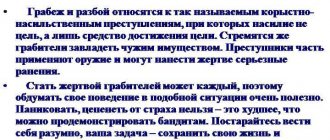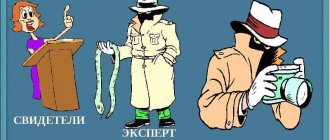In Russia, property is protected by law. But thefts of various things and objects occur every day, and victims turn to the police to report a crime.
The legislation of the Russian Federation defines the concept of theft, describes the main characteristics, and also provides for liability and appropriate punishment for the crime committed. All these norms are regulated in Art. 158 of the Criminal Code of the Russian Federation.
In our material we will tell you more about theft from the point of view of criminal law.
Composition and qualifying signs of theft
Any crime requires an object and a subject. In our case, the object of theft will be someone else's property. The objective side is characterized by the following points:
- the taking of property occurred without the consent of the owner;
- There were no owners or witnesses during the theft.
In this case, the criterion for the sacrament of theft should include the following points:
- the owner or other persons were absent;
- happened in the presence of the owner, but unnoticed by others;
- committed in the presence of persons who are not aware of the criminal intent of the thief;
- the criminal thought that no one had seen him, but neighbors noticed him or a surveillance camera was installed.
The subject of theft can only be a legally capable person who has reached the age of 14 years. The subjective side of this act suggests that the attacker intentionally committed it, wanting to take possession of someone else’s property, while pursuing selfish goals. Consequently, the thief subsequently planned to use the stolen property for personal purposes or wanted to sell the stolen property and receive a monetary reward for it.
Note!
Theft will be considered theft only if the criminal took possession of the thing, otherwise the crime is simply an attempt to steal.
In order to correctly classify the type of theft and assign the appropriate punishment, you should know the signs that characterize it as a criminal offense under Art. 158 of the Criminal Code of the Russian Federation. Determining the severity of the crime and the amount of punishment for the thief depend on these criteria.
Forms of theft
Forms and types of theft:
- Theft (Article 158). Punishable by a fine of up to 80 thousand rubles. or imprisonment for up to 2 years.
- Fraud (Article 159). The penalty in the form of a fine will be up to 1 million rubles, and the term of imprisonment will be up to 10 years.
- Misappropriation or embezzlement (Article 160). A fine of up to 120 thousand rubles may be imposed. or imprisonment for up to 2 years.
- Robbery (Article 161). In the absence of aggravating features, there is no fine, and the term of imprisonment can reach up to 4 years.
- Robbery (Article 162). Punishment is provided in the form of a fine of up to 500 thousand rubles. or imprisonment for up to 8 years.
- Theft of especially valuable items (Article 164). The fine for it can reach 500 thousand rubles, and the term of imprisonment can be up to 10 years.
Note! The maximum fine for the listed crimes committed under qualifying circumstances is 1 million rubles. The term of imprisonment can reach 10 years, for robbery - 12 years, for robbery and theft of valuable property - 15 years.
Types of theft
The classification depends on the characteristics characterizing the composition of the theft committed by the attacker. Let's highlight the main types:
- committed by a group of subjects;
- burglary;
- causing significant damage to the property owner;
- stealing from the victim's clothing or bag.
Let's look at each type in more detail and talk about their features.
Theft by a group of persons
It is impossible to characterize this crime unambiguously. At first glance, everything is clear that a group of subjects means two or more people, but there are significant nuances:
- a prerequisite is that both offenders are legally competent, and the age of the criminals allows them to be brought to justice. For example, when a 40-year-old woman and a 12-year-old boy steal someone else's property, the theft will not be considered a group crime, since a thief under 14 years old cannot be held criminally liable. Therefore, a criminal who has reached the appropriate age will bear full responsibility for the act committed;
- theft will not be considered a group theft even in the case where there was only one perpetrator, and the other accomplices are instigators.
Theft committed by a group of persons is divided into the following types - by prior agreement of the subjects and without it. Thus, theft committed by several persons by agreement must be confirmed when determining the punishment. Evidence can be the testimony of the group members themselves, witnesses, or documents of the criminals (for example, found records of preparation for a crime). Thus, to prove collusion between group members, conclusive evidence must be presented in court.
Break-in
Statistics show that the most common crime is burglary. To illegally enter someone else's premises (house, apartment, store, warehouse, etc.), attackers can break doors or windows to achieve their goal. In this case, such an invasion will be proven if there are certain signs:
- broken bolts and locks;
- damaged windows or doors;
- damage to the alarm or video surveillance system;
- intentional shutdown of the power supply to the premises.
Theft committed by burglary is an aggravating circumstance of the crime, but when qualifying such an act, the court will also take into account the damage caused to the owner, which will significantly increase the term of criminal punishment and the amount of the fine.
Causing significant damage to a citizen
Theft causing significant material damage to the property owner is interpreted quite ambiguously. The legislation establishes an amount of 5,000 rubles, which is considered significant when qualifying a crime and cannot be less than this amount. At the same time, there is a significant reservation under which the court must determine the amount of material damage caused taking into account the property status of the victim. This means that you need to take into account the significance of the damage for the victim, his level of income in the form of wages, pensions, etc.
Quite often, when considering cases, the court takes into account only the total criterion of stolen property. Many experts do not agree with this, since for wealthier citizens this amount may exceed their daily pocket expenses, and for ordinary people it can be several months’ income.
To qualify a theft as such, two points must be taken into account - the lower limit of the value of the stolen property and the deterioration of the victim’s property status.
From clothes, bags or other carry-on luggage
Based on the comments and practice of court decisions, we will consider some of the features of this theft:
- the crime must be committed only by a living person;
- theft implies that the clothes were worn by the owner, and the things were in the victim’s field of vision;
- the seizure of property from a sleeping or drunk person does not have signs related to this type of theft.
Therefore, when considering such cases, the court will be based on all the circumstances and impose an appropriate punishment.
When is theft considered a completed crime?
The crime is considered completed when dangerous consequences occur. It may seem that the theft is complete at the moment the valuables are removed, but this is not so. Having read the definition of theft to the end, you can understand that the purpose of theft is not the removal of valuables, but their conversion in favor of the criminal or third parties.
That is, the goal of the act is achieved not at the moment of seizure of material assets, but when the criminal can freely dispose of them or has already disposed of them at his own discretion. It is at this moment that the theft is complete.
Completed theft
Due to the emergence in Russia of a large number of shopping centers, supermarkets and other retail facilities in which goods are freely available to visitors, thefts at such retail outlets occur frequently. Just as often, the question arises as to whether the theft is complete if the goods were seized, but the criminal was detained at the exit by security. Using the example of such a theft, we will explain when it is complete.
Let's say a criminal decides to steal a chocolate bar. If he put it in his pocket and went to the exit, planning to eat it on the street, but was detained by security, the crime is not over. If the attacker ate a chocolate bar right on the sales floor and was then detained by security, then the act is completed, since he disposed of the object of the theft.
The minimum amount of damage to initiate a criminal case in 2017 is 2.5 thousand rubles. For minor thefts, including food, liability will most likely be administrative.
The possible amount of punishment depends on whether the crime of which you or your loved ones are accused is declared completed or not. Not everyone can protect their rights on their own. Contact a lawyer immediately after filing charges. An initial consultation with lawyers can be obtained online. You can ask any questions you are interested in using the form on the website or by calling the numbers provided. A specialist will examine the charges against you, correctly classify the crime and monitor the progress of the investigation.
Aggravating circumstances
When assigning a sentence, the court takes into account aggravating circumstances. These include:
- conspiracy between participants preceding the crime;
- theft committed by an organized group of entities;
- illegal entry into someone else's premises;
- theft on an especially large scale.
If you have become a victim and your property has been stolen, immediately contact law enforcement agencies and file a statement. Also use the services of our lawyers, who will help you correctly draw up a statement, study the details of the case and represent your interests in court.
How to write a term paper on speech therapy
07.09.2010 262611
These guidelines are compiled to help students gain an understanding of the content and structure of coursework in speech therapy.
Logopedia of pedagogical science that studies anomalies of speech development with normal hearing, explores the manifestations, nature and mechanisms of speech disorders, develops the scientific basis for overcoming and preventing them means of special training and education.
The subject of speech therapy as a science is speech disorders and the process of training and education of persons with speech disorders.
The object of study is a person suffering from a speech disorder.
The main task of speech therapy as a science is the study, prevention and elimination of various types of speech disorders.
Coursework in speech therapy is a student's scientific and experimental research. This type of educational activity, provided for by the educational and professional program and curriculum, contributes to the acquisition of skills in working with literature, analyzing and summarizing literary sources in order to determine the range of insufficiently studied problems, determining the content and methods of experimental research, processing skills and qualitative analysis of the results obtained. The need to complete coursework in speech therapy is due to the updating of knowledge concerning the content, organization, principles, methods and techniques of speech therapy work.
As a rule, during their studies, students must write two term papers - theoretical and practical.
The first course work should be devoted to the analysis and synthesis of general and specialized literature on the chosen topic. Based on this analysis, it is necessary to justify and develop a method of ascertaining (diagnostic) experiment.
In the second course work, it is necessary to provide an analysis of the results obtained during the ascertaining experiment, as well as determine the directions and content of speech therapy work, and select adequate methods and techniques of correction.
So, let’s present the general requirements for the content and design of coursework in speech therapy.
The initial and most important stage of working on a course project is the choice of a topic, which is either proposed by the supervisor or chosen by the student independently from a list of topics that are consistent with the areas of scientific research of the department.
Each topic can be modified, considered in different aspects, but taking into account a theoretical and practical approach. Having chosen a topic, the student needs to think through in detail its specific content, areas of work, practical material, etc., which should be reflected both in the formulation of the topic and in the further construction of the study. It should be recalled that the chosen topic may not only have a purely theoretical orientation, for example: “Dysarthria. Characteristics of the defect”, “Classification of dysgraphia”, but also take into account the practical significance of the problem under consideration, for example: “Speech therapy work on speech correction for dysarthria”. It should also be taken into account that when formulating a topic, excessive detail should be avoided, for example: “Formation of prosodic components of speech in preschoolers of the sixth year of life attending a preschool institution for children with severe speech impairments.”
The course work includes such mandatory parts as: introduction, three chapters, conclusion, bibliography and appendix.
The text of the term paper begins with the title page . An example of its design can be seen here.
Then the content of the work is given, in which the names of chapters, paragraphs, and sections are formulated in strict accordance with the content of the thesis. An example of its design can be seen here.
In the text, each subsequent chapter and paragraph begins on a new page. At the end of each chapter, the materials are summarized and conclusions are formulated.
The introduction reveals the relevance of the problem under consideration in general and the topic being studied in particular; the problem, subject, object, and purpose of the study are defined. In accordance with the goal and hypothesis, objectives and a set of research methods aimed at achieving the objectives must be defined.
The relevance of the topic lies in reflecting the current level of pedagogical science and practice, meeting the requirements of novelty and usefulness.
When defining the research problem, it is important to indicate what practical tasks it will help to implement in training and educating people with speech pathology.
The object of research is understood as certain aspects of pedagogical reality, perceived through a system of theoretical and practical knowledge. The ultimate goal of any research is to improve this object.
The subject of research is some part, property, element of an object, i.e. the subject of research always indicates a specific aspect of the object that is to be studied and about which the researcher wants to gain new knowledge. An object is a part of an object.
You can give an example of the formulation of the object, subject and problem of research:
– The object of the study is the speech activity of preschool children with phonetic-phonemic speech disorders.
– The subject of the study is the features of intonation speech of children with phonetic-phonemic speech disorders.
– The research problem is to determine effective directions for speech therapy work on the formation of intonation expressiveness of speech in the system of correctional intervention.
The purpose of the study contributes to the specification of the object being studied. The goal of any research is to solve a specific problem. The goal is specified in tasks taking into account the subject of research.
The research objectives are formulated in a certain sequence, which determines the logic of the research. The research objectives are set on the basis of a theoretical analysis of the problem and an assessment of the state of its solution in practice.
The first chapter is an analysis of literary sources, which examines the state of this problem in historical and modern aspects, and presents the most important theoretical principles that formed the basis of the study.
When writing the first chapter, you should pay attention to the fact that the text of the course work must be written in a scientific style. When presenting scientific material, it is necessary to comply with the following requirements:
– Specificity – a review of only those sources that are necessary to disclose only a given topic or solve only a given problem;
– Clarity – which is characterized by semantic coherence and integrity of individual parts of the text;
– Logicality – which provides for a certain structure of presentation of the material;
– Reasoning – evidence of thoughts (why this and not otherwise);
– Precision of wording, excluding ambiguous interpretation of the authors’ statements.
A literary review of the state of the problem being studied should not be reduced to a consistent presentation of literary sources. It should present a generalized description of the literature: highlight the main directions (currents, concepts, points of view), analyze in detail and evaluate the most fundamental works of representatives of these directions.
When writing a work, the student must correctly use literary materials, make references to the authors and sources from which the results of scientific research are borrowed. Failure to provide required references will reduce your coursework grade.
As a rule, in coursework on speech therapy, references to literary sources are formatted as follows: the number of the cited source in the general list of references is placed in square brackets. For example: General speech underdevelopment is a speech pathology in which there is a persistent lag in the formation of all components of the language system: phonetics, vocabulary and grammar [17].
When using quotations, in square brackets, in addition to indicating the source number, the page number from which this excerpt is taken is indicated, for example: Speech rhythm is based on a physiological and intellectual basis, since, firstly, it is directly related to the rhythm of breathing. Secondly, being an element that performs a communicative function, “correlates with meaning, i.e. controlled intellectually” [23, P.40].
However, course work should not be of a purely abstract nature, so you should not abuse the unreasonable abundance of citations. Quoting should be logically justified, convincing and used only when really necessary.
In the second chapter , devoted to experimental research, the organization should be described and the program of the ascertaining experiment should be presented. The survey methodology, as a rule, consists of a description of several series of tasks, with detailed instructions, visual and lexical material, the procedure for completing tasks by experiment participants, and scoring criteria. This chapter also provides a qualitative and quantitative analysis of the results obtained.
When analyzing the results of an experiment, it is necessary to use a scoring system. Examples of various criteria for quantitative and qualitative assessment are presented in the following works:
– Glukhov V.P. Formation of coherent speech in preschool children with general speech underdevelopment. - M.: Arkti, 2002. - 144 p.
– Fotekova T.A. Test methodology for diagnosing oral speech of primary schoolchildren. - M.: Arkti, 2000. - 56 p.
– Levchenko I.Yu. Pathopsychology: Theory and practice. - M.: Academy, 2000. - 232 p.
In order to visually present the results obtained during the experimental study, it is recommended to use tables, graphs, diagrams, etc. Histograms can be used in a variety of ways - columnar, cylindrical, planar, volumetric, etc. An example of the design of tables, figures, and histograms can be found here.
The third chapter provides a rationale for the proposed methods and techniques and reveals the content of the main stages of correctional work.
The conclusion contains a summary of the material presented and the main conclusions formulated by the author.
The bibliography must contain at least 25 sources. The list includes bibliographic information about the sources used in preparing the work. An example of its design can be seen here.
In the application you can present bulky tables or illustrations, examination protocols, observation records, products of activity (drawings, written works of children), notes from speech therapy classes, etc.
The volume of one course work must be at least 30 pages of typewritten text.
In general, coursework in speech therapy is the basis for a future thesis, in which the study of the begun problem can be continued, but from the standpoint of a different approach or a comparative analysis of the disorders being studied in different age categories of people with different types of speech disorders.
The content and format of theses in speech therapy can be found here.
Literature:
1. How to write a term paper on speech therapy: Methodological recommendations. Educational and methodological manual / Comp. Artemova E.E., Tishina L.A. / Ed. Orlova O.S. – M.: MGOPU, 2008. – 35 p.
2. Research work of students in the system of higher professional pedagogical education (specialty 031800 - Speech therapy). Methodological recommendations for completing the thesis / Compiled by. L.V. Lopatina, V.I. Lipakova, G.G. Golubeva. - St. Petersburg: Publishing house of the Russian State Pedagogical University named after. A. I. Herzen, 2002. - 140 p.








